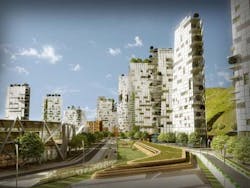Urban growth doesn’t have to destroy nature—it can work with it
Our collective desire to live in cities has never been stronger. According to the World Health Organization, 60% of the world’s population will live in a city by 2030. As urban populations swell, what people demand from their cities is evolving.
In India and China, developers have embarked on ambitious projects aimed at promoting interactivity between people and the environment by creating “generous cities.” In generous cities, the natural setting guides designers as they integrate environmental, social and economic systems. The goal is for the built environment to function as efficiently as the local ecosystem.
Created with Biomimicry 3.8, HOK’s Fully Integrated Thinking (FIT) tool enables designers to inform their decision-making by crunching data from 15 categories to determine a city’s characteristics. From transportation and commerce, to water and atmosphere, these categories reveal a setting’s strengths and weaknesses.
In Lavasa, India, and Meixi Lake, China, HOK planners, urban designers and architects worked with Biomimicry 3.8 biologists to recreate ecosystem services in the built environment. We wanted to move closer to achieving a city where biodiversity blossoms and living conditions promote well-being.
“We have to figure out what those ecosystem functions are, deem them important enough to replace and then determine how to do it in the built environment,” says Jamie Dwyer, a biologist and design strategist who worked on the Genius of Biome report created by HOK and Biomimicry 3.8.
In Lavasa, a deciduous forest ecosystem set on 12,500 acres of land southwest of Pune, the natural habitat had been annihilated by four centuries of slash-and-burn agriculture. The team set out to create a city where sustainable interactivity reigns. The plan calls for five urban villages, connected by footbridges and featuring nature-inspired buildings, to make up the city.
The key for the designers was to identify the most important ecosystem services in Lavasa’s biome. Water collection, storage and filtration are crucial, as the city sees 30 feet of rainfall during monsoon season, followed by a period of drought.
Read the full post at Life at HOK
About the author: Thomas Knittel, AIA, LEED AP BD+C, is a senior principal of design in HOK’s Los Angeles studio. He is the firm’s leading expert in biomimicry—drawing inspiration from natural systems to solve human problems—and holds a Biomimicry Specialty Certificate from Biomimicry 3.8. The organization also honored him with the 2013 Excellence in Biomimicry Award. More on Knittel.
About the Author

Life at HOK
HOK is a global design, architecture, engineering and planning firm. Through a network of 24 offices, HOK provides design excellence and innovation to create places that enrich people's lives and help clients succeed. Life at HOK is a group blog authored by the firm’s creative people across the world. Visit hoklife.com.
